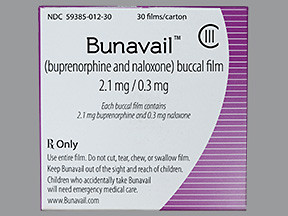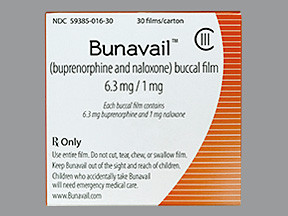BUPRENORPHINE/NALOXONE FILM - BUCCAL
PHONETIC PRONUNCIATION: (BUE-pre-NOR-feen/nal-OX-one)
COMMON BRAND NAME(S): Bunavail
GENERIC NAME(S): buprenorphine HCl/naloxone HCl
Uses
USES: This medication contains 2 medicines: buprenorphine and naloxone. It is used to treat opioid (narcotic) dependence/addiction. Buprenorphine belongs to a class of drugs called mixed opioid agonist-antagonists. Buprenorphine helps prevent withdrawal symptoms caused by stopping other opioids. Naloxone is an opioid antagonist that blocks the effect of opioids and can cause severe opioid withdrawal when injected. Withdrawal is less likely when naloxone is taken by mouth. It is combined with buprenorphine to prevent abuse and misuse (injection) of this medication. This combination medication is used as part of a complete treatment program for drug abuse (such as compliance monitoring, counseling, behavioral contract, lifestyle changes).
How to use BUPRENORPHINE/NALOXONE FILM - BUCCAL
HOW TO USE: Read the Medication Guide provided by your pharmacist before you start using this medication and each time you get a refill. If you have any questions, ask your doctor or pharmacist. Use this medication as directed by your doctor, usually once daily. Before using, rinse your mouth with water or use your tongue to wet the inside of your cheek. Use the tip of a dry finger to place one film inside your mouth with the text side facing against one cheek. Press and hold the film in place for 5 seconds, then remove your finger. The film should stay in place on its own after this. Leave it in place until it is dissolved. Do not move the strip with your tongue/finger or drink or eat food until the film has completely dissolved. If your doctor directs you to use more than one film at the same time, do not place one on top of the other. Place one film on each side of your mouth. Do not cut, tear, chew, or swallow the film. Doing so will make this medication work less well. Do not inject ("shoot up") buprenorphine/naloxone. Injecting it is dangerous, and will likely cause severe withdrawal symptoms due to the naloxone in this medication, especially if you have been using opioids such as heroin, morphine, or methadone. Buprenorphine alone may be used instead of this medication for the first 2 days after you have stopped all other opioids. It is usually given in your doctor's office. Your doctor will then switch you to this combination buprenorphine/naloxone medication for maintenance treatment. Do not change forms of this medication without your doctor's instructions. The dosage is based on your medical condition and response to treatment. Your doctor will adjust the dose until there are no symptoms of withdrawal. Do not switch between sublingual tablets/film or buccal film, because you may need a different dose if you switch. Do not increase your dose or use this drug more often or for longer than prescribed. Properly stop the medication when directed. Use this medication regularly to get the most benefit from it. To help you remember, use it at the same time each day. This medication may cause withdrawal reactions, especially if it has been used regularly for a long time or in high doses. In such cases, withdrawal symptoms (such as diarrhea, restlessness, watering eyes, runny nose, nausea, sweating, muscle aches) may occur if you suddenly stop using this medication. To prevent withdrawal reactions, your doctor may reduce your dose gradually. Consult your doctor or pharmacist for more details, and report any withdrawal reactions right away. Keep this medicine in a safe place to prevent theft, misuse, or abuse. If a child accidentally swallows this drug, get medical help right away.
Side Effects
Precautions
Interactions
Overdose
Images
Reviews
Faq for BUPRENORPHINE/NALOXONE FILM - BUCCAL
Buprenorphine/Naloxone Film - Buccal is used to treat opioid dependence and addiction.
Buprenorphine/Naloxone Film - Buccal works by binding to the same opioid receptors in the brain that are targeted by opioids, thus reducing withdrawal symptoms and cravings.
You should place the film in your mouth against your cheek and let it dissolve completely. Do not chew or swallow the film.
The dosage of Buprenorphine/Naloxone Film - Buccal depends on individual needs and should be determined by a healthcare professional. Do not change the dosage without consulting your doctor.
Common side effects may include nausea, headache, constipation, and sweating. Inform your doctor if you experience any severe side effects such as difficulty breathing, severe drowsiness, or allergic reactions.
It is generally advised to avoid alcohol while using Buprenorphine/Naloxone Film - Buccal, as it can increase the risk of side effects and reduce the effectiveness of the medication.
Buprenorphine/Naloxone Film - Buccal may cause drowsiness and impair your ability to drive or operate machinery. It is important to assess your individual response to the medication before engaging in such activities.
Abruptly stopping Buprenorphine/Naloxone Film - Buccal can result in withdrawal symptoms. It is recommended to consult your doctor for a proper tapering plan before discontinuing the medication.
It is important to discuss the risks and benefits of using Buprenorphine/Naloxone Film - Buccal during pregnancy or breastfeeding with your healthcare provider. They can guide you to make an informed decision.
Disclaimer
IMPORTANT: HOW TO USE THIS INFORMATION: This is a summary and does NOT have all possible information about this product. This information does not assure that this product is safe, effective, or appropriate for you. This information is not individual medical advice and does not substitute for the advice of your health care professional. Always ask your health care professional for complete information about this product and your specific health needs.





No Reviews Yet